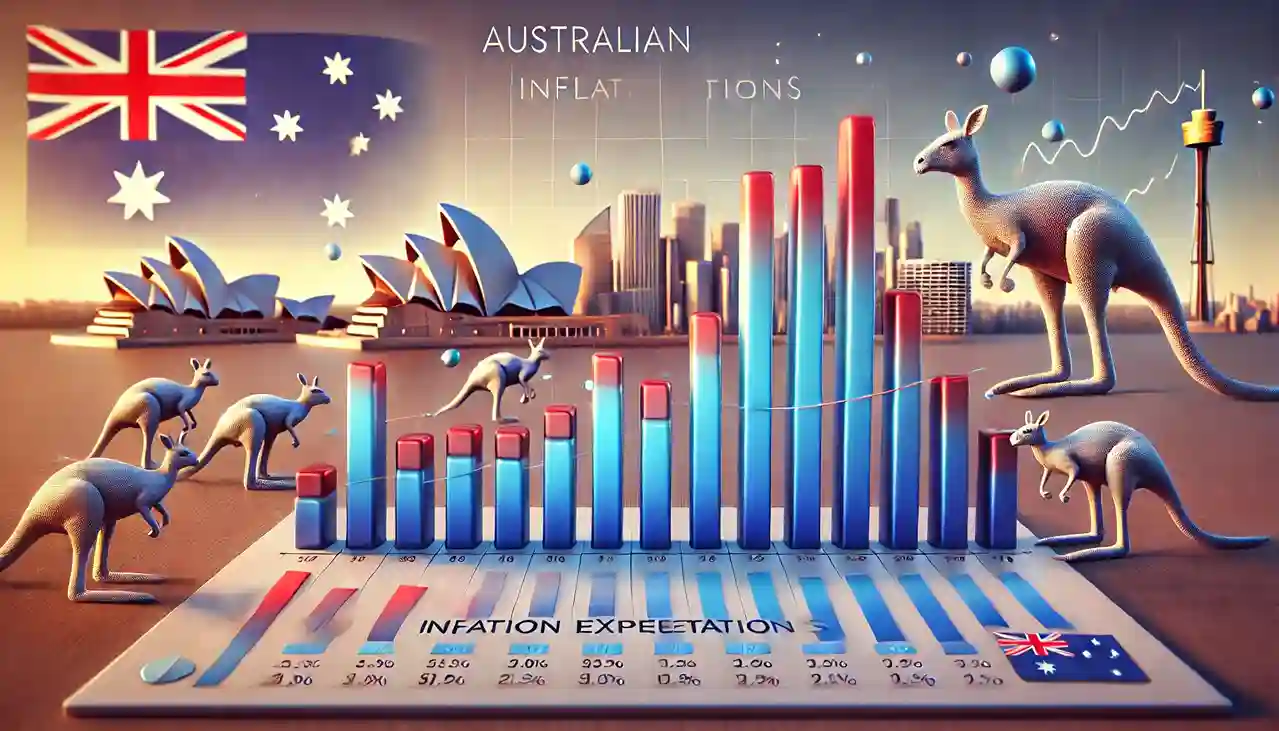Understanding inflation expectations is crucial for forex traders, especially when dealing with a dynamic economy like Australia’s. In this article, we’ll delve into the intricacies of Australian inflation expectations and how they can impact forex trading. By the end of this guide, you’ll have a comprehensive understanding of the topic and how to leverage this knowledge in your trading strategies.

What are Inflation Expectations?
Inflation expectations refer to the rate at which people—consumers, businesses, and investors—anticipate prices will rise in the future. These expectations are significant because they can influence actual inflation. If people expect higher inflation, they might spend more now, increasing demand and pushing prices up.
Understanding inflation expectations can provide insights into the future direction of interest rates. Central banks, like the Reserve Bank of Australia (RBA), monitor these expectations to set monetary policies.
The Role of the Reserve Bank of Australia (RBA)
The RBA plays a pivotal role in managing inflation expectations. Its primary objective is to maintain price stability, typically aiming for a 2-3% inflation rate. The RBA uses tools like interest rate adjustments to influence inflation.
When inflation expectations are high, the RBA might raise interest rates to cool down the economy. Conversely, if expectations are low, it might cut rates to spur economic activity. Forex traders need to watch RBA announcements closely, as these can lead to significant market movements.
How Inflation Expectations Impact Forex Trading
Inflation expectations can cause currency values to fluctuate. For example, if Australian inflation expectations rise, the RBA might increase interest rates to combat inflation. Higher interest rates can attract foreign investors seeking better returns, increasing demand for the Australian dollar (AUD).
On the flip side, if expectations are low and the RBA cuts rates, the AUD might weaken as investors look for better opportunities elsewhere. Forex traders need to stay informed about inflation trends to make informed trading decisions.
Key Indicators of Australian Inflation Expectations

Several indicators can help traders gauge Australian inflation expectations:
- Consumer Price Index (CPI): This measures changes in the price level of a basket of consumer goods and services.
- Producer Price Index (PPI): Reflects changes in the prices received by domestic producers for their output.
- Inflation Surveys: Conducted by institutions like the Melbourne Institute, these surveys provide insights into public and business inflation expectations.
By monitoring these indicators, traders can anticipate potential moves by the RBA and adjust their strategies accordingly.
The Impact of Global Events on Australian Inflation
Global events can significantly impact Australian inflation expectations. For instance, fluctuations in global oil prices can affect domestic fuel costs, influencing overall inflation. Trade tensions, natural disasters, and geopolitical issues can also play a role.
Forex traders must keep an eye on global news and understand how international events can ripple through the Australian economy. A sudden spike in oil prices due to a geopolitical conflict, for example, could lead to higher inflation expectations and prompt the RBA to act.
Historical Trends in Australian Inflation
Understanding historical trends can provide valuable context for current inflation expectations. Over the past few decades, Australia has experienced periods of both high and low inflation. For instance, during the 1970s and 80s, inflation was relatively high, prompting significant monetary policy adjustments.
In recent years, inflation has been more subdued, partly due to global economic conditions and technological advancements. Analyzing these trends can help traders predict future movements and make more informed decisions.
Economic Factors Influencing Inflation
Several economic factors can influence inflation, including:
- Wage Growth: Higher wages can lead to increased consumer spending, driving up prices.
- Supply Chain Disruptions: These can lead to shortages and higher prices for goods and services.
- Currency Fluctuations: A weaker AUD can make imports more expensive, contributing to higher inflation.
Understanding these factors can help traders anticipate changes in inflation expectations and adjust their strategies accordingly.
The Relationship Between Inflation and Interest Rates

Interest rates and inflation are closely linked. When inflation expectations rise, central banks often raise interest rates to cool the economy. Higher interest rates can attract foreign investment, increasing demand for the currency.
Conversely, when inflation expectations are low, central banks may cut rates to stimulate economic activity. This can weaken the currency as investors seek higher returns elsewhere. Forex traders need to understand this relationship to make informed trading decisions.
Strategies for Trading Based on Inflation Expectations
Forex traders can use several strategies to trade based on inflation expectations:
- Fundamental Analysis: This involves analyzing economic indicators, central bank announcements, and global events to anticipate currency movements.
- Technical Analysis: Traders can use charts and historical data to identify trends and patterns related to inflation expectations.
- Diversification: Spreading investments across different currencies can reduce risk and capitalize on varying inflation expectations.
By combining these strategies, traders can better navigate the complexities of the forex market.
Case Study: Australian Inflation During the COVID-19 Pandemic
The COVID-19 pandemic had a significant impact on global economies, including Australia. During the early stages of the pandemic, inflation expectations plummeted as economic activity slowed. The RBA responded by cutting interest rates to record lows and implementing other measures to support the economy.
As the economy began to recover, inflation expectations started to rise, prompting discussions about when the RBA might begin tightening monetary policy. This period provides valuable lessons for traders on how sudden economic shocks can influence inflation expectations and central bank actions.
Common Mistakes Traders Make with Inflation Expectations
Even experienced traders can make mistakes when trading based on inflation expectations. Some common errors include:
- Ignoring Global Events: Failing to consider international developments can lead to inaccurate predictions.
- Overreliance on One Indicator: Relying solely on one economic indicator can provide an incomplete picture of inflation expectations.
- Not Adapting to Changing Conditions: Markets are dynamic, and traders need to adapt their strategies as new information becomes available.
Avoiding these mistakes can improve trading outcomes and reduce risks.
Tools and Resources for Monitoring Inflation Expectations

Several tools and resources can help traders monitor inflation expectations:
- Economic Calendars: These provide dates and times for key economic releases and central bank announcements.
- Financial News Websites: Keeping up with financial news can provide insights into inflation trends and potential market movements.
- Trading Platforms: Many trading platforms offer tools and indicators for analyzing inflation expectations.
Utilizing these resources can help traders stay informed and make better decisions.
Conclusion
Understanding Australian inflation expectations is essential for forex traders looking to navigate the complexities of the market. By monitoring key indicators, staying informed about global events, and using effective trading strategies, traders can capitalize on opportunities and manage risks. Remember, the forex market is dynamic, and staying adaptable is key to long-term success.
FAQs
1. How does inflation impact forex trading?
Inflation affects currency values by influencing central bank policies. Higher inflation can lead to higher interest rates, attracting foreign investment and increasing demand for the currency.
2. What tools can I use to monitor Australian inflation expectations?
Tools like economic calendars, financial news websites, and trading platforms with analytical tools can help you stay informed about inflation trends.
3. How do global events impact Australian inflation?
Global events such as changes in oil prices, trade tensions, and geopolitical issues can influence domestic inflation by affecting the cost of imports and overall economic conditions.
4. What are some common mistakes traders make with inflation expectations?
Common mistakes include ignoring global events, overrelying on one economic indicator, and not adapting to changing market conditions.
5. How did the COVID-19 pandemic affect Australian inflation expectations?
The pandemic initially caused inflation expectations to drop due to reduced economic activity. However, as the economy recovered, expectations began to rise, influencing central bank policies.
